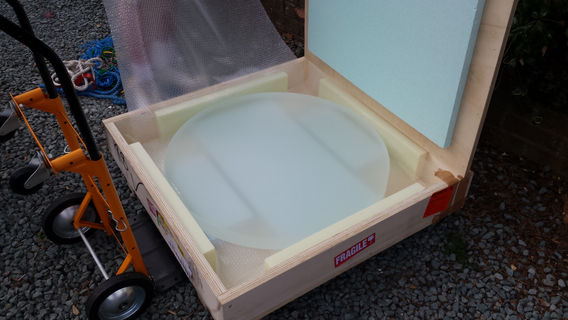Making the 30 inch F3 Telescope
This was not the first 30 inch aperture telescope that we had made. The first was back in the early 90's and was the first optical set I had ever made.
My good friend Geoff Regan, who passed away a few years ago, helped make this telescope and most of the other telescopes that I made. David Owen also helped a lot in the making of the telescopes but has now moved to Spain for clear skies! Therefore this telescope shall be know as the Thomson/Regan/Owen Telescope.
This is one of the largest telescopes in the UK and is used on a regular basis. A high resolution spectrograph will be fitted soon. A number of cameras are available and it can be used visually if required. It can be used locally but is also fully automated to be used remotely.
The mirror blank was bought from Reginato in Italy. This came generated to F3 and fine annealed. The surface was fine ground with a large tile too then polished before figuring with a large pitch lap.
Figuring was done with different sized laps and tested with a Foucault tester, Bath Interferometer and Star testing. Testing and figuring was completed when all 3 tests matched in results.
I will add more about the building and testing of the telescope as I develope this web site.
The optical specification of the M1 primary is as follows: -
-
Substrate: Fine annealed Supremax33
-
Material diameter: 760mm
-
Thickness 55mm
-
Mass is Approximately 55 Kg
-
ROC approximately 4564mm
-
Reference wavelength: 550nm
-
Conic constant: -1
-
Approximately 60/40 No significant visible scratches or digs can be seen on the optical surface.
The final ‘clear aperture’ was measured by removing the central area occupied by the secondary and the outer 3mm of the mirror. This cannot be achieved in FigureXP as there is no ability to do this.
-
FigureXP: Strehl (Horizontal 0.97 + Vertical 0.867)/2 = 0.918
-
FigureXP: Surface RMS (Horizontal 7.7 + Vertical 16.4)/2 = 12.05 nm RMS
-
OpenFringe: Strehl of 0.919
-
OpenFringe: Surface of 12.73 nm RMS = (1/21.6 *550)/2)
Therefore, the surface error is nominally 12 nm RMS on the surface. A 3D output of the surface ‘clear aperture’ is shown below.
Some images below show the blank being:-
-
Delivered
-
Smoothed with the tile tool
-
Polished on the polishing machine
-
Polsihing machine shown how it can be rotated ready testing
-
18 point balance wiffle tree
-
Dew heaters on the rear of the primary
-
Loading the mirror into the telescope base box
-
A few images of the telescope at first light in 2023















